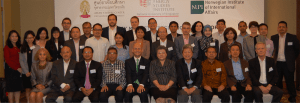Energy security and connectivity:
The Nordic and European Union Approaches24-26 November, 2015
Hotel Jen Tanglin, Singapore(held under the Chatham House Rule)
Objectives
The Forum will develop ASEAN-wide approaches to governing energy connectivity and energy security. Particular attention will be paid to evaluating the applicability of the Nordic approach, and to contrasting this approach with that taken by the European Union. This issue is particularly timely, given the ongoing deliberations on the Lao People’s Democratic Republic-Thailand-Malaysia-Singapore Power Integration Project (LTMS PIP), as part of the deployment of the ASEAN Power Grid (APG).
The Forum will strive to adopt, at its conclusion, concrete steps to formulating policy advice on ASEAN connectivity and the APG, particularly with regard to the LTMS PIP. It will focus on three main questions:
- How do Nordic energy co-operation institutions operate and how do they compare with institutions in the European Union and the North American Electrical Reliability Corporation?
- How does the Nordpool electricity exchange operate and what accounts for its success?
- What conclusions can be drawn for ASEAN and, in particular, for the design of LTMS PIP as a preliminary test for the ASEAN Power Grid (APG)?
Outcomes
Participants agreed that a market study needs to be conducted to analyze the rationale for commercial cross border power trading among the LTMS parties, taking into account cost competitiveness of hydro-electricity trading in competitive markets, sustainable solutions for management of wheeling and transmission losses, and efficient deployment of renewable energy sources across ASEAN in the framework of the APAEC 2016- 2025 agreed targets.
The participants agreed that a market study needed to be conducted to analyse the rationale for commercial cross-border power trading among the LTMS parties, taking into account the cost competitiveness of hydro-electricity trading in competitive markets, sustainable solutions for management of wheeling and transmission losses, and efficient deployment of renewable energy sources across ASEAN in the framework of the APAEC (2016-2025) agreed targets.
To move forward with power trading across ASEAN, the participants recommended that ASEAN-relevant entities (ACE, APGCC, HAPUA and AERN) prepare a strategic plan together with a roadmap and step-wise approach to delivering it. The strategic plan would include the following objectives, to be presented at the Special Senior Officials Meeting on Energy from 25 to 26 January 2016 for their endorsement:
- Address standards and legal frameworks related to multilateral commercial agreements;
- Develop an approach for utilities to make the transition into a commercial mode of regional operation, and agree a path to get there;
- Conduct a study of options to decouple energy subsidies from electricity prices, while continuing to assist the poor (welfare neutral action), and analyse the impact on consumers and GDP growth from subsidy removal from electricity prices;
- Conduct a feasibility study for the creation of an ASEAN power exchange, inspired by the Norwegian commodity exchange, and estimate expected electricity spot prices in ASEAN markets as well as their competitiveness relative to current bilateral trading prices;
- Send a delegation of ASEAN officials to visit electricity exchanges to investigate their operational model, examine their pricing algorithms, and learn from their success and failures. These exchanges would include Nord Pool Spot (Oslo), Southern Africa and India.
Forum papers
- Overview
- Concept Note
- Agenda
- Participants List
- Biographical Notes
- Conclusions and Forum Statement
- Forum Proceedings
- Connecting ASEAN through the power grid: Next Steps
- Preface
- Energy Security and Energy Connectivity in the Context of ASEAN Energy Market Integration (Philip Andrews-Speed)
- Nordic Political and Economic Cooperation: Context, History and Outlook (Johan Strang)
- Nordic Energy Policy Cooperation (Birte Holst Joergensen)
- The Nord Pool Market Model (Hans-Arild Bredesen)
- Energy Security and Energy Connectivity in the Context of ASEAN European Energy Market Integration (Christian Egenhofer and Fabio Genoese)

